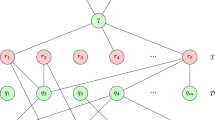Abstract
The study of finite groups whose prime graphs do not contain triangles is continued. The main result of this paper is the following theorem: if G is a finite nonsolvable group whose prime graph contains no triangles and S(G) is the greatest solvable normal subgroup of G, then |π(G)| ≤ 8 and |π(S(G))| ≤ 3. A detailed description of the structure of a group G satisfying the conditions of the theorem is obtained in the case when π(S(G)) contains a number that does not divide the order of the group G/S(G). We also construct an example of a finite solvable group of Fitting length 5 whose prime graph is a 4-cycle. This completes the determination of the exact bound for the Fitting length of finite solvable groups whose prime graphs do not contain triangles.
Similar content being viewed by others
References
O. A. Alekseeva and A. S. Kondrat’ev, “Finite groups whose prime graphs do not contain triangles. I,” Proc. Steklov Inst. Math. 295 (Suppl. 1), S11–S20 (2016).
A. S. Kondrat’ev, A. A. Osinovskaya, and I. D. Suprunenko, “On the behavior of elements of prime order from a Singer cycle in representations of a special linear group,” in Abstracts of the XI Belarusian Mathematical Conference, Minsk, Belarus, 2012, pp. 34–35.
A. S. Kondrat’ev and I. V. Khramtsov, “On finite triprimary groups,” Trudy Inst. Mat. Mekh. UrO RAN 16 (3), 150–158 (2010).
A. S. Kondrat’ev and I. V. Khramtsov, “On finite tetraprimary groups,” Proc. Steklov Inst. Math. 279 (Suppl. 1), S43–S61 (2012).
V. D. Mazurov, “Characterizations of finite groups by sets of the orders of their elements,” Algebra Logic 36 (1), 23–32 (1997).
N. D. Podufalov, “Finite simple groups without elements of sixth order,” Algebra Logic 16 (2), 133–135 (1977).
M. Aschbacher, Finite Group Theory (Cambridge Univ. Press, Cambridge, 1986).
C. Jansen, K. Lux, R. Parker, and R. Wilson, An Atlas of Brauer Characters (Clarendon, Oxford, 1995).
J. H. Conway, R. T. Curtis, S. P. Norton, R. A. Parker, and R. A. Wilson, Atlas of Finite Groups (Clarendon, Oxford, 1985).
J. N. Bray, D. F. Holt, and C. M. Roney-Dougal, The Maximal Subgroups of the Low-Dimensional Finite Classical Groups (Cambridge Univ. Press, Cambridge, 2013), Ser. London Math. Soc. Lect. Note 407.
R. Brandl, “Finite groups all of whose elements are of prime power order,” Boll. Un. Mat. Ital. A 18 (3), 491–493 (1981).
L. Dornhoff, Group Representation Theory, (Dekker, New York, 1971), Part A.
P. Fleischmann, W. Lempken, and P. H. Tiep, “Finite p′-semiregular groups,” J. Algebra 188 (2), 547–579 (1997).
L. R. Fletcher, B. Stellmacher, and W. B. Stewart, “Endliche Gruppen, die kein Element der Ordnung 6 enthalten,” Quart. J. Math. Oxford, Ser. 2, 28 (110), 143–154 (1977).
The GAP Group (GAP—Groups, Algorithms, and Programming), Version 4.4.12. http://www.gap-system.org
L. M. Gordon, “Finite simple groups with no elements of order six,” Bull. Austral. Math. Soc. 17 (2), 235–246 (1977).
D. Gorenstein, Finite Simple Groups (Harper and Row, New York, 1968).
D. Gorenstein, R. Lyons, and R. Solomon, The Classification of the Finite Simple Groups (Amer. Math. Soc., Providence, RI, 1998), Ser. Math. Surveys and Monographs 40 (3).
G. Higman, “Finite groups in which every element has prime power order,” J. London Math. Soc. 32, 335–342 (1957).
G. Higman, Odd Characterizations of Finite Simple Groups: Lecture Notes (Univ. Michigan, Ann Arbor, MI, 1968).
M. C. Lucido, “Groups in which the prime graph is a tree,” Boll. Unione Mat. Ital. B 5 (1), 131–148 (2002).
W. B. Stewart, “Groups having strongly self-centralizing 3-centralizers,” Proc. London Math. Soc. 426 (4), 653–680 (1973).
M. Suzuki, “On a class of doubly transitive groups,” Ann. Math. 75 (1), 105–145 (1962).
Author information
Authors and Affiliations
Corresponding author
Additional information
Original Russian Text © O.A. Alekseeva, A.S. Kondrat’ev, 2016, published in Trudy Instituta Matematiki i Mekhaniki UrO RAN, 2016, Vol. 22, No. 1.
Rights and permissions
About this article
Cite this article
Alekseeva, O.A., Kondrat’ev, A.S. Finite groups whose prime graphs do not contain triangles. II. Proc. Steklov Inst. Math. 296 (Suppl 1), 19–30 (2017). https://doi.org/10.1134/S0081543817020031
Received:
Published:
Issue Date:
DOI: https://doi.org/10.1134/S0081543817020031



